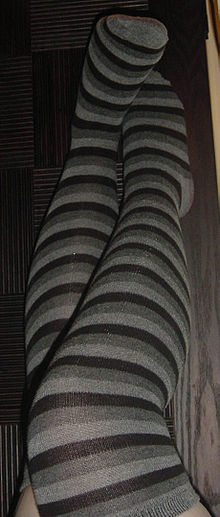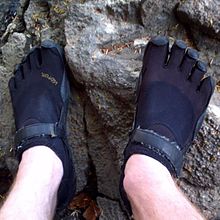Footwear


Footwear refers to garments worn on the feet, which typically serves the purpose of protection against adversities of the environment such as wear from ground textures and temperature. Footwear in the manner of shoes therefore primarily serves the purpose to ease locomotion and prevent injuries. Footwear can also be used for fashion and adornment as well as to indicate the status or rank of the person within a social structure. Socks and other hosiery are typically worn additionally between the feet and other footwear for further comfort and relief. Cultures have different customs regarding footwear. These include not using any in some situations, usually bearing a symbolic meaning. This can however also be imposed on specific individuals to place them at a practical disadvantage against shod people, if they are excluded from having footwear available or are prohibited from using any. This usually takes place in situations of captivity, such as imprisonment or slavery, where the groups are among other things distinctly divided by whether or whether not footwear is being worn.
In some cultures, people remove their shoes before entering a home. Bare feet are also seen as a sign of humility and respect, and adherents of many religions worship or mourn while barefoot. Some religious communities explicitly require people to remove shoes before they enter holy buildings, such as temples.
In several cultures people remove their shoes as a sign of respect towards someone of higher standing. In a similar context deliberately forcing other people to go barefoot while being shod oneself has been used to clearly showcase and convey one's superiority within a setting of power disparity.
Practitioners of the craft of shoemaking are called shoemakers, cobblers, or cordwainers.
History

Footwear has been in use since the earliest human history, archeological finds of complete shoes date back to the Chalcolithic (ca. 5000 BCE).
The Romans saw clothing and footwear as unmistakable signs of power and status in society, and most Roman citizens wore footwear, while slaves and peasants sometimes remained barefoot.[1] The Middle Ages saw the rise of high-heeled shoes, also associated with power, and the desire to look larger than life, and artwork from that period often depicts bare feet as a symbol of poverty. Depictions of captives such as prisoners or slaves from the same period well into the 18th century show the individuals barefooted almost exclusively, at this contrasting the prevailing partakers of the scene. Officials like prosecutors, judges but also slave owners or passive bystanders were usually portrayed wearing shoes. During the Middle Ages, men and women wore pattens, commonly seen as the predecessor of the modern high-heeled shoe,[2] while the poor and lower classes in Europe, as well as slaves in the New World, were usually barefoot.[3] In the 15th century, chopines were created in Turkey, and were usually 18–20 cm (7–8 inches) high. These shoes became popular in Venice and throughout Europe, as a status symbol revealing wealth and social standing.
During the 16th century, royalty such as Catherine de Medici and Mary I of England began wearing high-heeled shoes to make them look taller or larger than life. By 1580, men also wore them, and a person with authority or wealth might be described as, well-heeled. In modern society, high-heeled shoes are a part of women's fashion and are widespread in certain countries around the world.[4]

Materials
Modern footwear is usually made up of leather or plastic, and rubber. In fact, leather was one of the original materials used for the first versions of a shoe.[5] The soles can be made of rubber or plastic, sometimes having a sheet of metal inside. Roman sandals had sheets of metal on their soles so that it would not bend out of shape.
More recently, footwear providers like Nike, have begun to source environmentally friendly materials.[6]
Components

Types
Boots
Shoes


- Shoes
- Athletic shoes (also known as trainers or sneakers)
- Ballet flats
- Brothel creepers
- Court shoes (known in the US as pumps)
- Diabetic shoes
- Espadrilles
- Galoshes
- Kitten heels
- Lace-up shoes
- High-tops
- Loafers
- Mary Janes
- Moccasins
- Monks
- Mules
- Platform shoes
- Plimsoll shoes
- School shoes
- Skate shoes
- Sneakers
- Tap shoes
- Toe shoes

Vibram FiveFingers toe shoes
Sandals
- Sandals
- Kolhapuri Chappals
- Peshawari chappal
- Flip-flops (thongs)
- Slide
- Wörishofer
- Avarca, from Balearic Islands

A pair of Sandals
Specific footwear

- Ballet shoes
- Boat shoes
- High-heeled footwear
- Climbing shoes
- Clogs
- Football boots
- Sabaton
- Safety footwear
- Sailing boots
- Ski boots
- Snowshoes
- Ice skates
- Surgical shoe
- Pointe shoes
- Swimfins (flippers)
- Barefoot sandals
Traditional footwear

- Abarka, of leather, from Pyrenees
- Areni-1 shoe, 5,500-year-old leather shoe found in Armenia
- Bast shoe, of bast, from Northern Europe
- Crakow, shoes from Poland with long toes popular in the 15th century
- Galesh, of textile, from Iran
- Geta, of wood, from Japan
- Klompen, of wood, from the Netherlands
- Opanci, of leather, from Balkans
- Pampooties, of hide, from Ireland
Socks



Footwear industry
In Europe, the footwear industry has declined in the last years. Whereas in 2005, there were about 27,000 firms, in 2008 there were only 24,000. As well as the number of firms, the direct employment has decreased. The only factors that remained almost steady was the value added at factor cost and production value.[citation needed]
In the U.S., the annual footwear industry revenue was $48 billion in 2012. In 2015, there were about 29,000 shoe stores in the U.S. and the shoe industry employed about 189,000 people.[7] Due to rising imports, these numbers are also declining. The only way of staying afloat in the shoe market is to establish a presence in niche markets.[8]
Safety of footwear products
To ensure high quality and safety of footwear, manufacturers have to make sure all products comply to existing and relevant standards. By producing footwear in accordance with national and international regulations, potential risks can be minimized and the interest of both textile manufacturers and consumers can be protected. The following standards/regulations apply to footwear products:
- CPSIA
- GB Standards such as
- GB20400-2006 Leather and fur-limit of harmful matter
- QB/T1002-2005 Leather shoes
- GB/T 15107 Athletic footwear
- EN Standards for Footwear
- ASTM Standards[9]
- ISO standards[10]
- AAFA Restricted Substance List
- BIS (ISI) : IS 15298-I: 2011 test methods, IS 15298 –II for safety footwear, IS 15298-III Protective footwear, IS 15298-IV Occupational Footwear
Impressions
Footwear can create two types of impressions: two-dimensional and three-dimensional impressions.[11] When footwear places material onto a solid surface, it creates a two-dimensional impression.[11][12] These types of impressions can be made with a variety of substances, like dirt and sand.[11] When footwear removes material from a soft surface, it creates a three-dimensional impression.[11][12] These types of impressions can be made in a variety of soft substances, like snow and dirt.[11] Two-dimensional impressions also differ from three-dimensional impressions because the latter demonstrate length, width, and depth whereas two-dimensional impressions only demonstrate the first two aspects.[12]
See also
References
- ^ DeMello, Margo (1 September 2009). Feet and footwear: a cultural encyclopedia. Macmillan. pp. 65–. ISBN 978-0-313-35714-5. Retrieved 29 January 2012.
- ^ "Dangerous Elegance: A History of High-Heeled Shoes". Retrieved July 1, 2010.
- ^ Frazine, Richard Keith (1993). The Barefoot Hiker. Ten Speed Press. p. 98. ISBN 0-89815-525-8.
- ^ Goonetilleke, Ravindra (2012). The Science of Footwear (Human Factors and Ergonomics). CRC Press. ISBN 978-1-4398-3568-5.
- ^ "The Fascinating History Of Footwear". All That Is Interesting. 2013-04-23. Retrieved 2016-10-24.
- ^ "What materials are used to make Nike shoes?". Reference. Retrieved 2016-10-24.
- ^ "Footwear Industry Statistics". www.statisticbrain.com. Archived from the original on 20 May 2015. Retrieved 2 May 2015.
- ^ "Shoe & Footwear Manufacturing in the US Market Research - IBISWorld". Retrieved 2 May 2015.
- ^ "Standard Specification for Performance Requirements for Protective (Safety) Toe Cap Footwear". Retrieved 5 July 2016.
- ^ "ISO - ISO Standards - ISO/TC 216 - Footwear". Retrieved 2 May 2015.
- ^ a b c d e Gardner, Ross M. (30 June 2021). Practical crime scene processing and investigation. ISBN 978-1-032-09443-4. OCLC 1255870591.
- ^ a b c Baxter Jr, E (2015). Complete Crime Scene Investigation Handbook. CRC Press. pp. 284–285.
Further reading
- Goonetilleke, R.S. (2012). The Science of Footwear. Human Factors and Ergonomics. Taylor & Francis. ISBN 978-1-4398-3568-5. 726 pages.
- Wilcox, R.T. (2008). The Mode in Footwear: A Historical Survey with 53 Plates. Dover Fashion and Costumes Series. Dover Publications. ISBN 978-0-486-46761-0. 190 pages.
- Riello, G. (2006). A Foot in the Past: Consumers, Producers and Footwear in the Long Eighteenth Century. Pasold studies in textile history. Pasold Research Fund/Oxford University Press. ISBN 0-19-929225-6. 302 pages.
External links
![]() Media related to Footwear at Wikimedia Commons
Media related to Footwear at Wikimedia Commons


